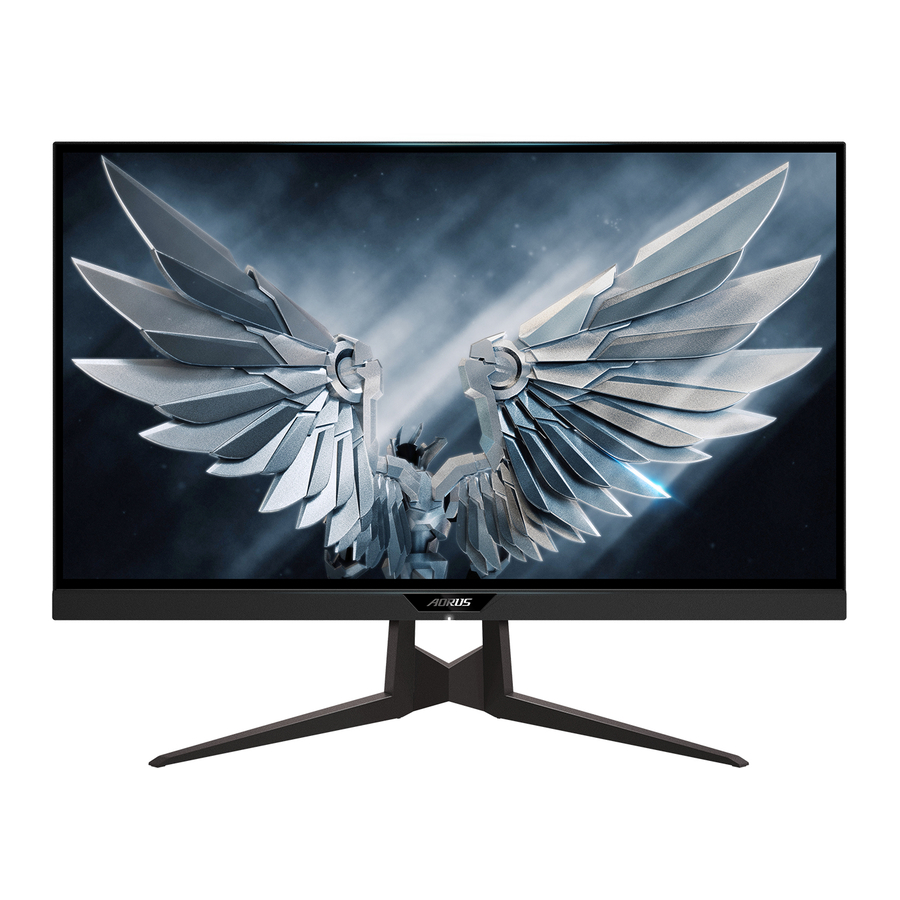
GIGABYTE AORUS FI27Q-P - Tactical Gaming Monitor Manual
- User manual (44 pages) ,
- User manual (44 pages)
Advertisement

INTRODUCTION
Unpacking
- Open the upper cover of the packaging box. Then observe the unpacking label attached on the inner cover.
- Making sure the box is in the correct orientation, carefully lay the box on the stable surface.
![GIGABYTE - AORUS FI27Q-P - Unpacking - Step 1 Unpacking - Step 1]()
- Open the inner cover.
![GIGABYTE - AORUS FI27Q-P - Unpacking - Step 2 Unpacking - Step 2]()
- Grab the EPS foam assembly (through the openings) to pull it out of the box.
![GIGABYTE - AORUS FI27Q-P - Unpacking - Step 3 Unpacking - Step 3]()
- Remove the items from the upper EPS foam.
![GIGABYTE - AORUS FI27Q-P - Unpacking - Step 4 Unpacking - Step 4]()
- Remove the upper EPS foam. Then you can remove the monitor from the lower EPS foam.
![GIGABYTE - AORUS FI27Q-P - Unpacking - Step 5 Unpacking - Step 5]()
Package Contents
The following items come with your packaging box. If any of them is missing, please contact your local dealer.
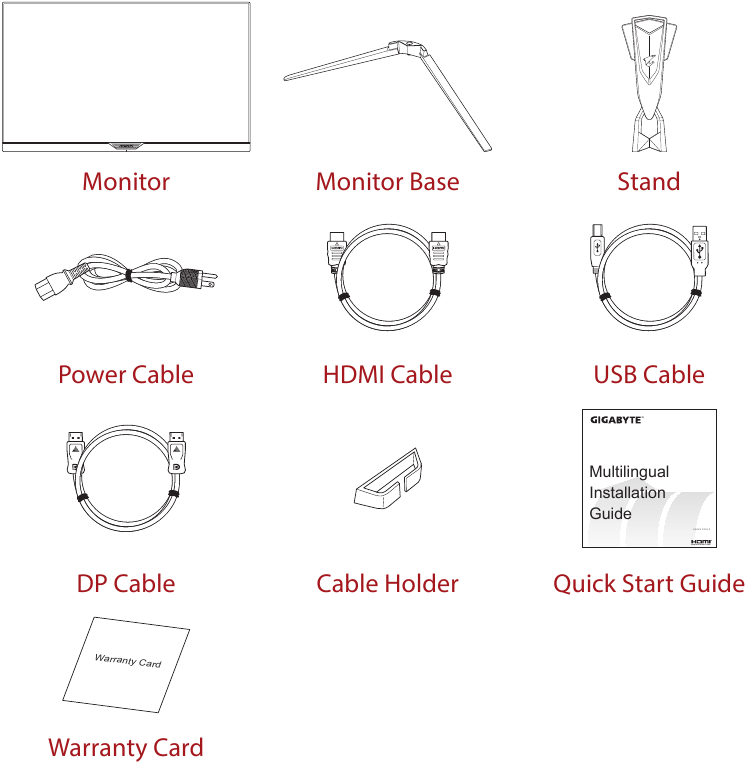
Note: Please keep the packaging box and packing materials for future transportation of the monitor.
Product Overview
Front View
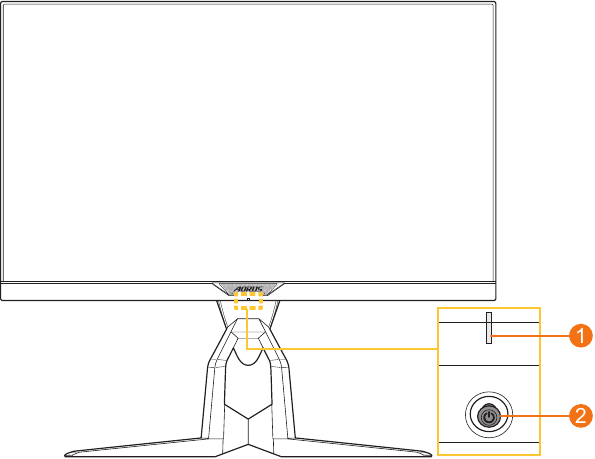
- Power LED
- Control button
Rear View
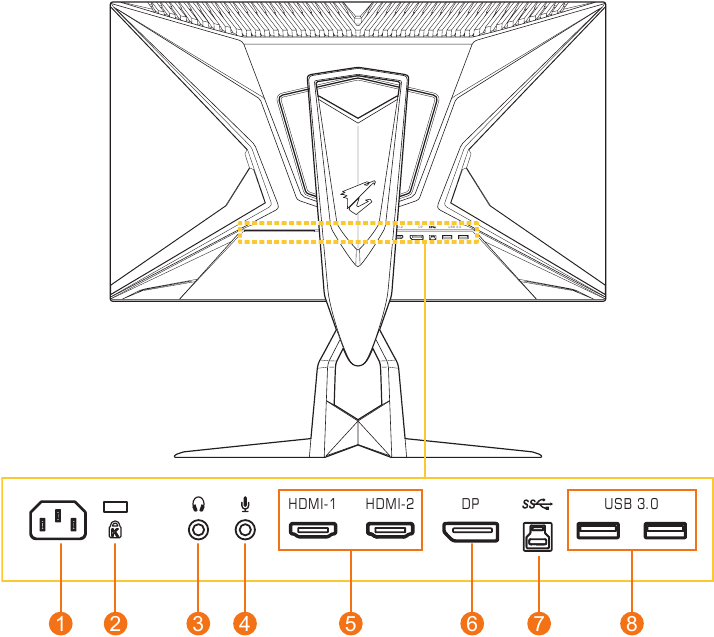
- AC IN jack
- Kensington lock
- Headphone jack
- Microphone jack
- HDMI ports (x2)
- DisplayPort
- USB upstream port
- USB 3.0 ports (x2)
GETTING STARTED
Installing the Monitor Base
- Place the monitor on the lower EPS foam, with the screen facing down.
- Align and slide the hooks of the stand into the mounting slots on the rear of the screen.
![GIGABYTE - AORUS FI27Q-P - Installing the Monitor Base - Step 1 Installing the Monitor Base - Step 1]()
- Align the monitor base with the standoff underneath the stand. Then attach the base onto the stand.
![GIGABYTE - AORUS FI27Q-P - Installing the Monitor Base - Step 2 Installing the Monitor Base - Step 2]()
- Tighten the screw to secure the monitor base in place.
![GIGABYTE - AORUS FI27Q-P - Installing the Monitor Base - Step 3 Installing the Monitor Base - Step 3]()
Note: You can either use a coin or a small flathead screwdriver to tighten the screw. - Lift the monitor to an upright position and place it on a table.
Adjusting the Viewing Angle
Note: Hold the monitor base so that the screen does not topple when you make the adjustment.
Adjusting the Tilt Angle
Tilt the screen forward or backward to the desired viewing angle (-5º to 21º).
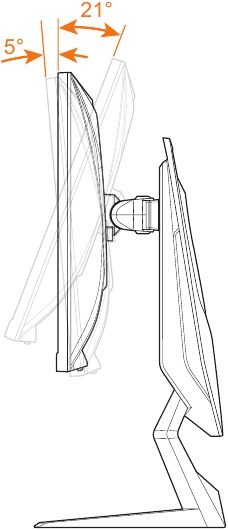
Adjusting the Swivel Angle
Swivel the screen to the left or right for the desired viewing angle (20º).
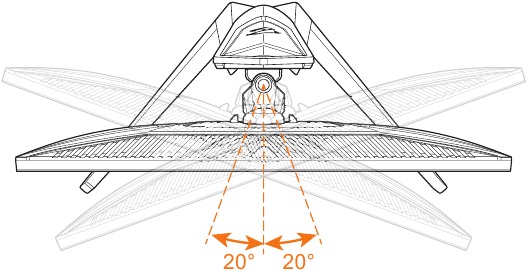
Changing the Screen Orientation
- Raise the screen to the highest position (130mm).
![]()
- Rotate the monitor (90º clockwise) to portrait orientation.
![GIGABYTE - AORUS FI27Q-P - Changing the Screen Orientation Changing the Screen Orientation]()
Installing a Wall-Mount Bracket (Optional)
Use only the 100 x 100 mm wall mount kit recommended by the manufacturer.
- Place the monitor on the lower EPS foam, with the screen facing down.
- Push the locking clips inward to detach the stand from the monitor.
![GIGABYTE - AORUS FI27Q-P - Installing a Wall-Mount Bracket - Step 1 Installing a Wall-Mount Bracket - Step 1]()
- Pull down the stand slightly to disengage the hooks. Then remove the stand.
![GIGABYTE - AORUS FI27Q-P - Installing a Wall-Mount Bracket - Step 2 Installing a Wall-Mount Bracket - Step 2]()
- Attach the mounting bracket to the mounting holes at the rear of the monitor. Then use the screws to secure the bracket in place.
![GIGABYTE - AORUS FI27Q-P - Installing a Wall-Mount Bracket - Step 3 Installing a Wall-Mount Bracket - Step 3]()
Note: To mount the monitor on the wall, refer to the installation guide that is included in the wall-mount bracket kit.
Making Connections
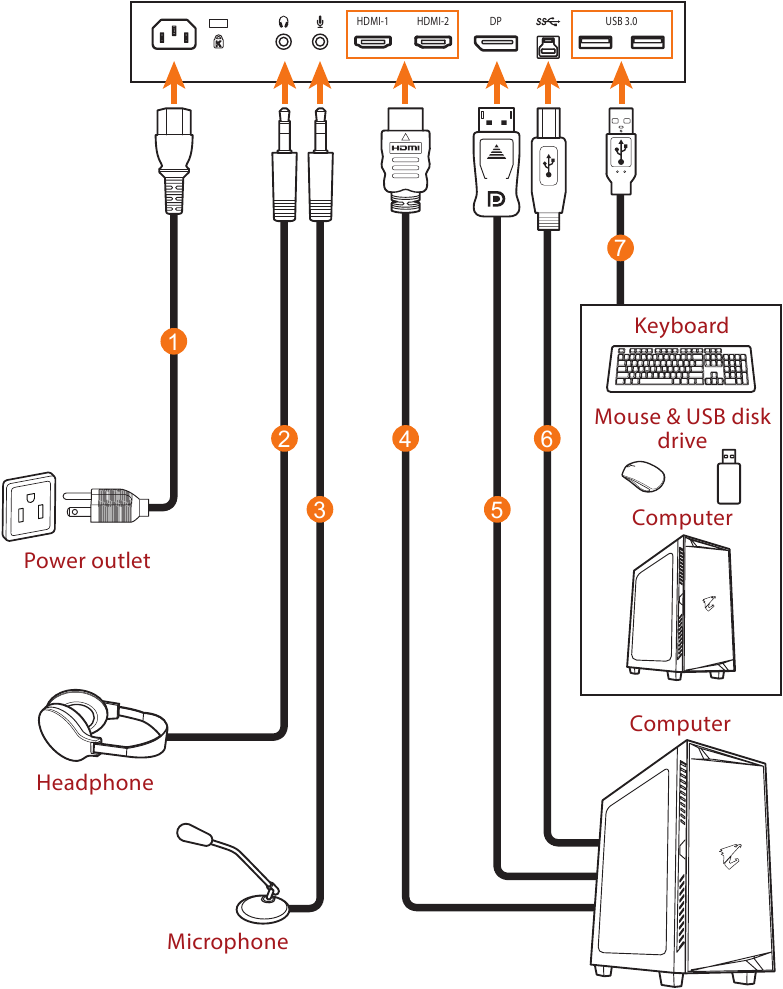
- Power cable
- Headphone cable
- Microphone cable
- HDMI cable
- DisplayPort cable
- USB (A-Male to B-Male) cable
- USB cable
USING THE DEVICE
Turning the Power On/Off
Power On
- Connect one end of the power cable to the AC IN jack at the rear of the monitor.
- Connect other end of the the power cable to a power outlet.
- Press the Control button to turn on the monitor. The Power LED will light in white, indicating the monitor is ready to use.
![GIGABYTE - AORUS FI27Q-P - Power On Power On]()
Note: If the Power LED remains off after you turn on the monitor, please check the LED Indicator setting in the Settings menu.
Power Off
Press the Control button for 2 seconds to turn off the monitor.
Note: When the Main menu appears on the screen, you can also turn off the monitor by moving the Control button down ( ).
).
Managing the Cables
- Align the cable clip with the clip holes at the rear of the monitor.
![GIGABYTE - AORUS FI27Q-P - Managing the Cables Managing the Cables]()
- Press the cable clip firmly until it is fully seated. Then route the connected cables through the clip.
User Comfort Recommendations
The following are some tips for comfortable viewing of your monitor:
- Optimal viewing distances for monitors range from approximately 510 mm to 760 mm (20" to 30").
- A general guideline is to position the monitor such that the top of the screen is at or slightly below your eye-height when you are comfortably seated.
- Use adequate lighting for the type of work you are performing.
- Take regular and frequent breaks (at least for 10 minutes) every halfhour.
- Be sure to periodically look away from your monitor screen and focus on a far object for at least 20 seconds during the breaks.
- Eye exercise can help reduce eye strain. Repeat these exercises frequently:
- look up and down
- slowly roll your eye
- move your eyes diagonally.
Selecting the Input Source
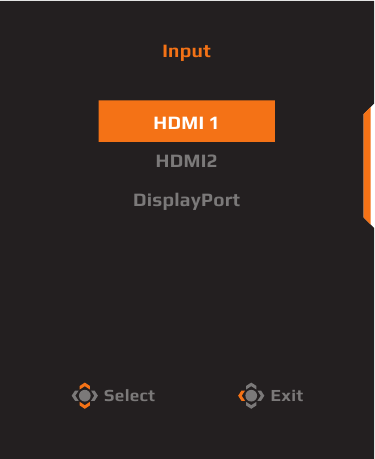
- Move the Control button right (
![]() ) to enter the Input menu.
) to enter the Input menu. - Move the Control button up/down (
![]() ) to select the desired input source. Then press the Control button to confirm.
) to select the desired input source. Then press the Control button to confirm.
OPERATIONS
Quick Menu
Hot Key
By default, the Control button has been assigned with the specific function.
Note: To change the preset hot key function, refer to the "Quick Switch" section.
To access the hot key function, do the following:
- Move the Control button up (
![]() ) to enter the Black Equalizer 2.0 menu.
) to enter the Black Equalizer 2.0 menu.
Move the Control button up/down (![]() ) to adjust the setting and press the Control button to confirm.
) to adjust the setting and press the Control button to confirm.
![GIGABYTE - AORUS FI27Q-P - Hot Key - Step 1 Hot Key - Step 1]()
- Move the Control button down (
![]() ) to enter the Picture Mode menu.
) to enter the Picture Mode menu.
Move the Control button up/down (![]() ) to select the desired option and press the Control button to confirm.
) to select the desired option and press the Control button to confirm.
![GIGABYTE - AORUS FI27Q-P - Hot Key - Step 2 Hot Key - Step 2]()
- Move the Control button left (
![]() ) to enter the Volume menu.
) to enter the Volume menu.
Move the Control button up/down (![]() ) to adjust the headphone volume level and press the Control button to confirm.
) to adjust the headphone volume level and press the Control button to confirm.
![GIGABYTE - AORUS FI27Q-P - Hot Key - Step 3 Hot Key - Step 3]()
- Move the Control button right (
![]() ) to enter the the Input menu. Refer to the "Selecting the Input Source" section.
) to enter the the Input menu. Refer to the "Selecting the Input Source" section.
Note: To close the menu, move the Control button left ( ).
).
Function Key Guide
Press the Control button to display the Main menu.
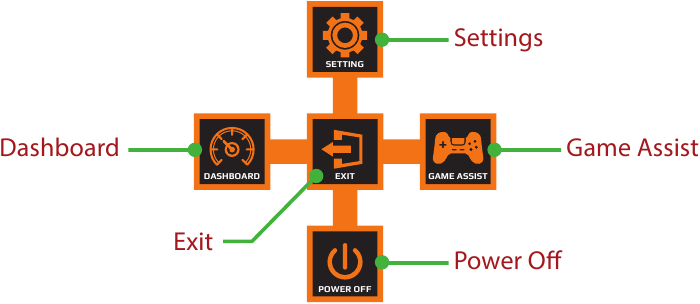
Then use the Control button to select the desired function and configure the related settings.
Dashboard
When the Main menu appears on the screen, move the Control button left ( ) to enter the Dashboard menu.
) to enter the Dashboard menu.
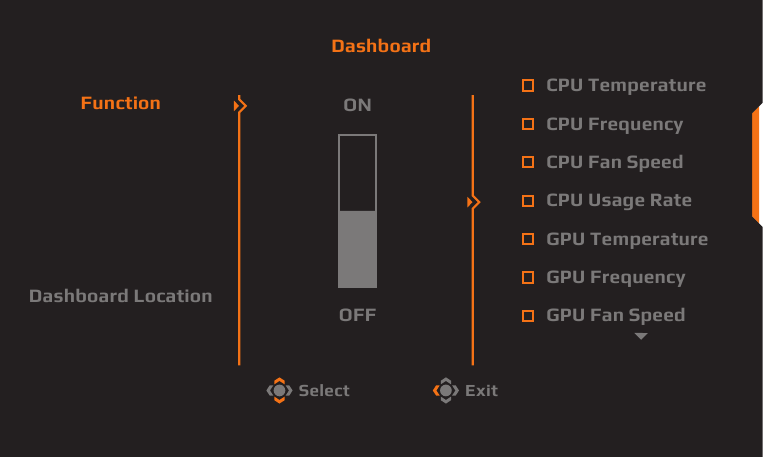
- Function: Enable/Disable the function. When enabled, you can select the desired option(s) to be shown on the screen.
- Dashboard Location: Specify the location of the Dashboard information to be shown on the screen.
Once the Dashboard configuration is complete, it will transfer the system data to the SOC through the USB port and display the value of the selected function(s) on the screen.
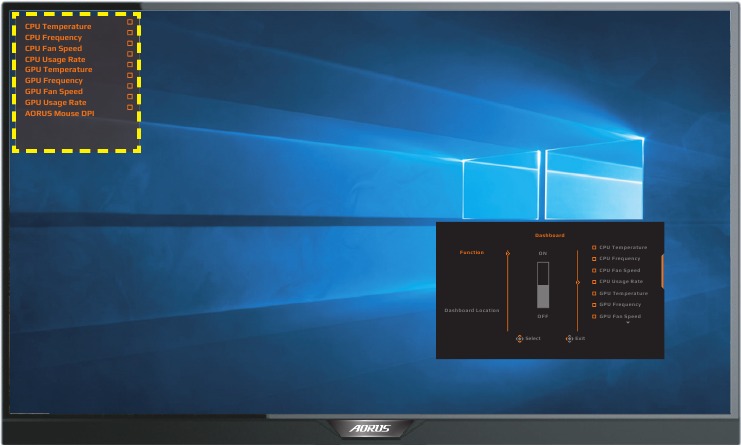
Note: Make sure the USB cable is properly connected to the USB upstream port of the monitor and the USB port of your computer.
Game Assist
When the Main menu appears on the screen, move the Control button right ( ) to enter the Game Assist menu.
) to enter the Game Assist menu.
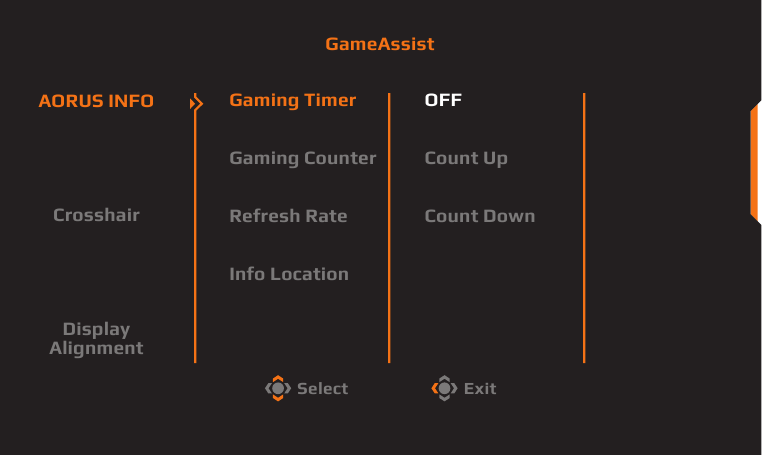
- AORUS INFO: Configure the FPS (First Person Shooting) game related settings.
- Select Gaming Timer to select countdown timer mode. To disable this function, set the setting to OFF.
- Select Gaming Counter or Refresh Rate to enable/disable the gaming counter or real-time refresh rate setting.
- Select Info Location to specify the location of the information to be shown on the screen.
![GIGABYTE - AORUS FI27Q-P - AORUS INFO AORUS INFO]()
- Crosshair: Select the desired crosshair type to suit your gaming environment. It makes aiming much easier.
- Display Alignment: When the function is enabled, it displays the alignment lines on the four sides of the screen, providing handy tool for you to line up multiple monitors perfectly.
Configure the Device Settings
When the Main menu appears on the screen, move the Control button up ( ) to enter the Settings menu.
) to enter the Settings menu.
Note: Use the Control button to navigate through the menu and make adjustments.
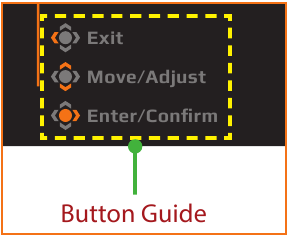
Gaming
Configure the game related settings.
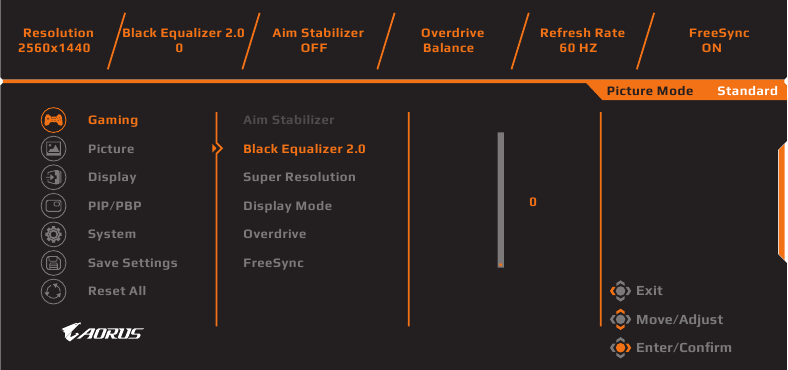
| Item | Description |
| Aim Stabilizer | When this function is enabled, it reduces the motion blur in a fast moving games. Note: This function is not available under the following conditions:
|
| Black Equalizer 2.0 | Adjust the brightness of the black areas. |
| Super Resolution | Sharpen the low resolution images. |
| Display Mode | Select the aspect ratio of the screen.
Note: This option is not compatible with FreeSync function. |
| Overdrive | Improve the response time of the LCD monitor. |
| FreeSync | When this function is enabled, it eliminates the screen lag and tearing while playing games. |
Picture
Configure the image related settings.
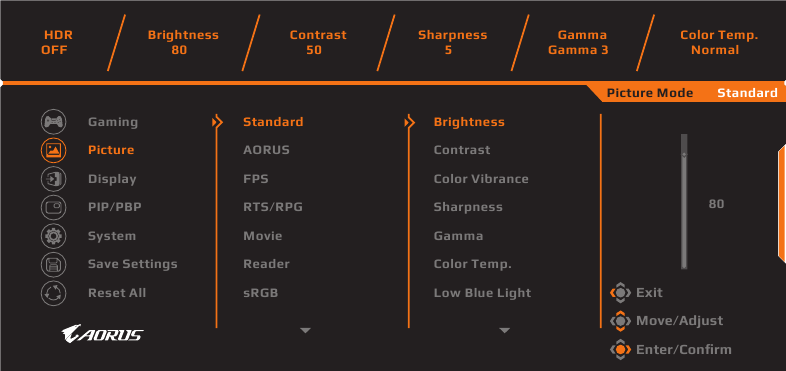
Select the one of the preset picture mode.
- Standard: For editing documents or browsing websites.
- AORUS: For playing AORUS GAMER games.
- FPS: For playing FPS (First Person Shooting) games.
- RTS/RPG: For playing RTS (Real-Time Strategy) or RPG (Role-Playing Game) games.
- Movie: For watching movies.
- Reader: For viewing documents.
- sRGB: For viewing photos and graphics on the computer.
- Custom 1: Customized picture mode settings.
- Custom 2: Customized picture mode settings.
- Custom 3: Customized picture mode settings.
Then you can configure the following image settings.
| Item | Description | ||
| Brightness | Adjust the brightness of the image. | ||
| Contrast | Adjust the contrast of the image. | ||
| Color Vibrance | Adjust the intensity of the more muted colors. | ||
| Sharpness | Adjust the sharpness of the image. | ||
| Gamma | Adjust the middle level of luminance. | ||
| Color Temperature | Select the color temperature. Note: Select User Define to customize the color temperature by adjusting the red (R), green (G), or blue (B) level according to your preference. | ||
| Low Blue Light | Reduce the amount of blue light exposure from the screen.
Note: Level 10 is optimized setting. It is compliance with TUV Low Blue Light Certification. | ||
| Dynamic Contrast | Adjust the black level of the image to achieve the optimum contrast. | ||
| Senseye Demo | Split the screen in half (2 windows). The image of the selected mode with its default settings will appear on the left window and the adjusted image with the new settings will appear on the right window. | ||
| Reset Picture | Reset all Picture settings to the default settings. |
Display
Configure the display screen related settings.
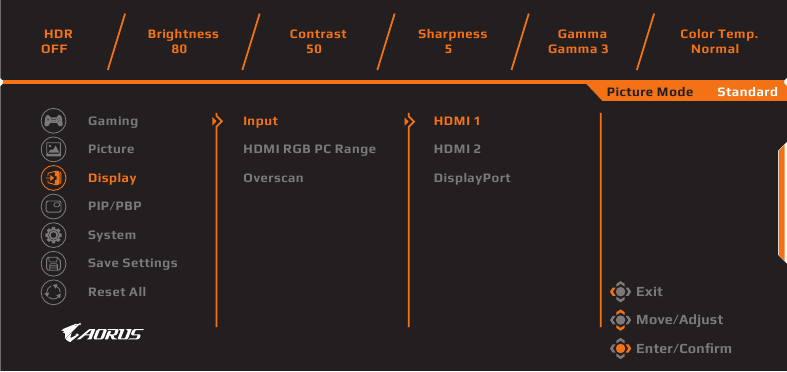
| Item | Description |
| Input | Select the input source. |
| HDMI RGB PC Range | Select an appropriate RGB range setting or let the monitor to detect it automatically. Note: This option is only available for HDMI input. |
| Overscan | When this function is enabled, it slightly enlarges the input image to hide the outermost edges of the image. Note: This option is only available for HDMI input. |
PIP/PBP
Configure the multi-picture related settings.
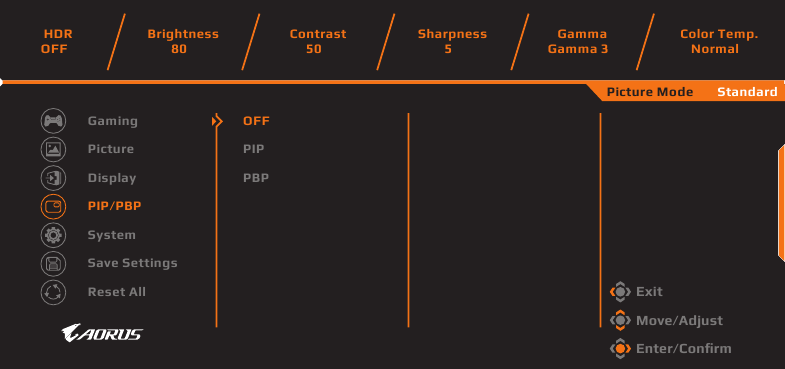
| Item | Description |
| OFF | Disable the PIP/PBP function. |
| PIP | Split the screen into 2 parts (main window and inset window).
|
| PBP | Display 1X1 split screen (left and right windows).
|
Note: PIP/PBP is not compatible with HDR and FreeSync functions.
System
Configure the system related settings.
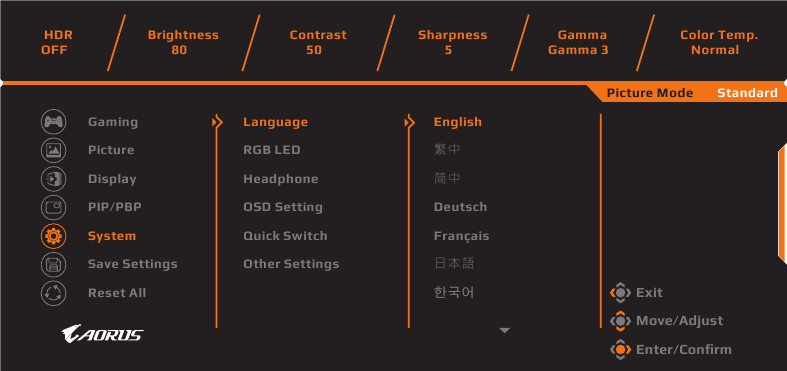
| Item | Description |
| Language | Select an available language for the OSD menu. |
| RGB LED | When this function is enabled, you can select the preset LED color and effect to be displayed on the rear of the monitor. |
| Headphone | Configure the headphone settings.
|
| OSD Settings | Configure the on-screen display (OSD) menu related settings.
|
| Quick Switch | Assign the function of the hot keys. Available options: Aim Stabilizer, Black Equalizer 2.0, Low Blue Light, Volume, Input, Contrast, Brightness, and Picture Mode. The default setting of the hot keys as below:
|
| Other Settings |
|
Save Settings
Set the personalized OSD configurations for Setting1, Setting2, or Setting3.
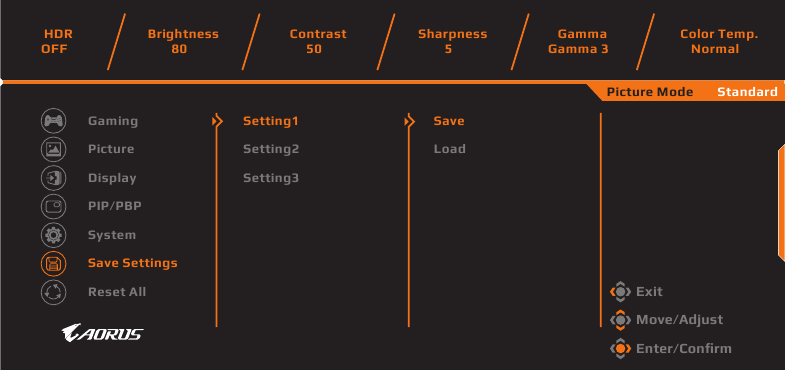
| Item | Description |
| Save | Save the customized settings. |
| Load | Load the saved settings. |
Reset All
Restore the monitor to its factory default settings.
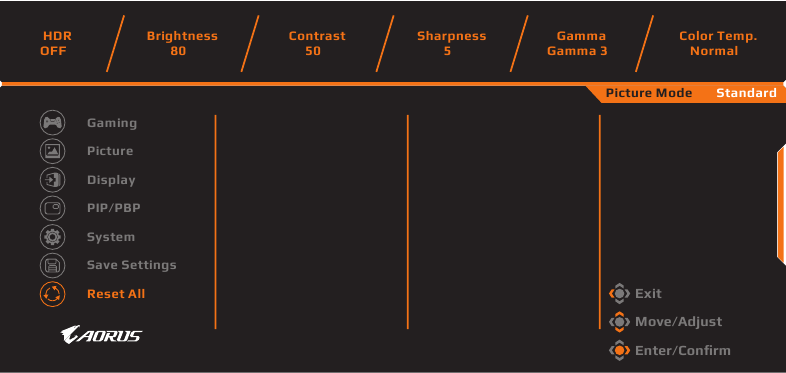
Specifications
| Item | Specifications | |
| Panel Size | 27-inch | |
| Aspect Ratio | 16:9 | |
| Resolution | 2560 x 1440 | |
| Refresh Rate | 165Hz | |
| LED Life | 30000 hours (min.) | |
| Pixel Pitch | 0.233 x 0.233 | |
| Response Time | 1 ms (MPRT) | |
| Brightness | 350nits (typ.) / 280nits (min.) | |
| Contrast Ratio | 1000:1 (typ.) | |
| Dynamic Contrast Ratio | 12M:1 (typ.) | |
| Color Depth | 1.073G | |
| Active Display Area | 596.736(H) x 335.664(V) | |
| Viewing Angle | 178º(H) / 178º(V) | |
| Frequency | 48~165Hz (gaming mode) | |
| Input/Output Terminals |
| |
| Power Supply | AC 100~240V at 50/60Hz | |
| Power Consumptions |
| |
| Dimensions (W x H x D) | 614.9 x 565.9 x 236.9mm (with stand) | |
| Weight | 8.0±0.5 kgs (Net) | |
| Temperature Range (operation) | 0ºC to 40ºC | |
Note: Specifications subject to change without notice.
Supported Timing List
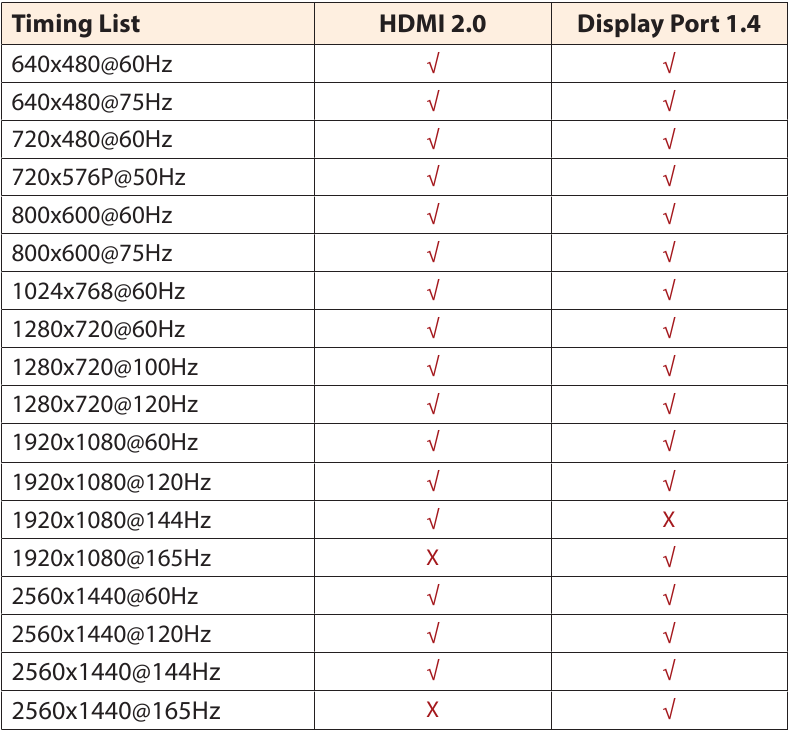
Troubleshooting
| Problem | Possible Solution(s) |
| No power |
|
| No image appears on the screen |
|
| The image does not fill the entire screen |
|
| The colors are distorted |
|
| No sound or volume is low |
|
Note: If the problem persists, please contact our customer service for further assistance.
Basic Care
When the screen becomes dirty, do the following to clean the screen:
- Wipe the screen with your soft, lint-free cloth to remove any residual dust.
- Spray or apply the cleaning fluid onto a soft cloth. Then wipe the screen gently with the damp cloth.
Note:
- Make sure that the cloth is damp, but not wet.
- When wiping, avoid applying excessive pressure on the screen.
- Acidic or abrasive cleaners can damage the screen.
Notes on USB Charging
The following devices are not compatible with BC 1.2 of CDP mode. When the Hub is connected to a PC, these devices cannot be charged using the USB cable.
| Vendor | Device | PID/VID |
| Apple | IPad | PID 129A/VlD 05AC |
| Samsung | GalaxyTab2 1 0.1 | PID 6860/VlD 04E8 |
| Samsung | GALAXYTabPro | PID 6860/VlD 04E8 |
SAFETY INFORMATION
Read through the following Safety Precautions before using the monitor.
- Only use the accessories that are provided with the monitor or that which are recommended by the manufacturer.
- Keep the plastic packaging bag for the product in a place that cannot be reached by children.
- Before connecting the monitor to the power outlet, make sure that the voltage rating of the power cable is compatible with the power specification in the country where you are located.
- The power cord plug must be connected to a properly wired and grounded power outlet.
- Do not touch the plug with wet hands, otherwise easily cause electric shock.
- Place the monitor in a stable and well-ventilated place.
- Do not place the monitor near any heat sources such as electric radiators or direct sunlight.
- The holes or openings on the monitor are for ventilation. Do not cover or block the ventilation holes with any objects.
- Do not use the monitor near water, drinks, or all types of liquids. Failure to do so may result in electric shock or damage to the monitor.
- Make sure to unplug the monitor from the power outlet before cleaning.
- As the screen surface is easy to be scratched, avoid touching the surface with any hard or sharp object.
- Use a soft lint-free cloth instead of a tissue to wipe the screen. You may use a glass cleaner to clean the monitor if required. However, never spray the cleaner directly onto the screen.
- Disconnect the power cable if the monitor is not being used for a long period of time.
- Do not attempt to disassemble or repair the monitor yourself.
GIGABYTE Service Information
More service information, please visit GIGABYTE official website: https://www.gigabyte.com/
Copyright
© 2019 GIGA-BYTE TECHNOLOGY CO., LTD. All rights reserved.
The trademarks mentioned in this manual are legally registered to their respective owners.
Disclaimer
Information in this manual is protected by copyright laws and is the property of GIGABYTE.
Changes to the specifications and features in this manual may be made by GIGABYTE without prior notice.
No part of this manual may be reproduced, copied, translated, transmitted, or published in any form or by any means without GIGABYTE's prior written permission.
- In order to assist in the use of this monitor, carefully read the User Guide.
- For more information, check on our website at: https://www.gigabyte.com

Documents / Resources
References
Download manual
Here you can download full pdf version of manual, it may contain additional safety instructions, warranty information, FCC rules, etc.
Download GIGABYTE AORUS FI27Q-P - Tactical Gaming Monitor Manual
Advertisement
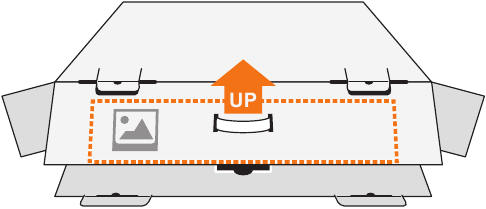
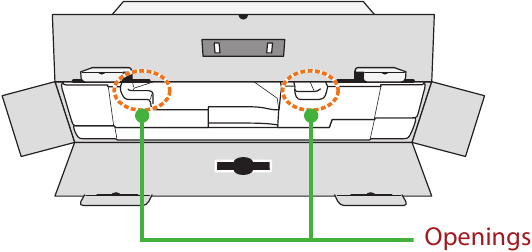
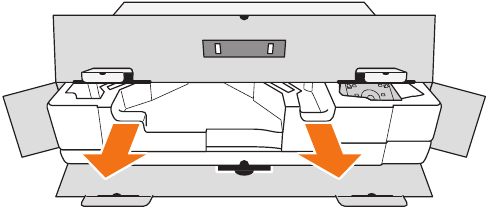
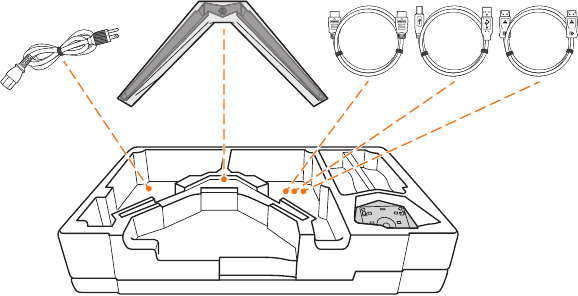
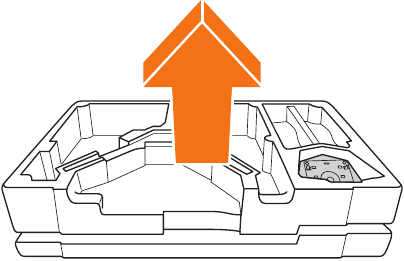
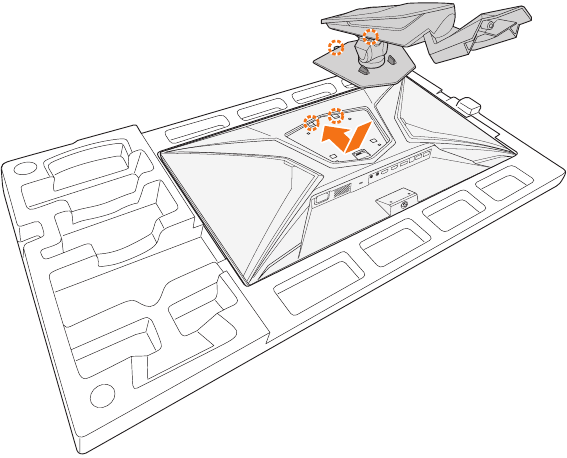


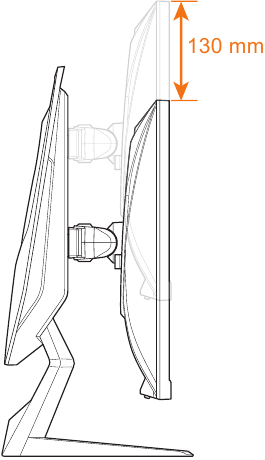

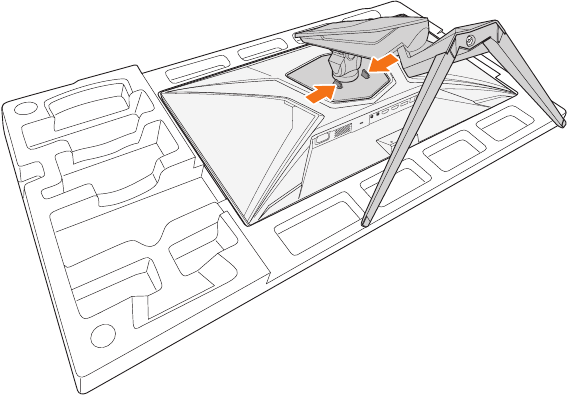




 ) to select the desired input source. Then press the
) to select the desired input source. Then press the 
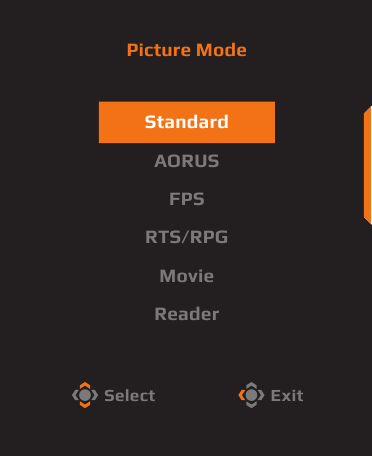
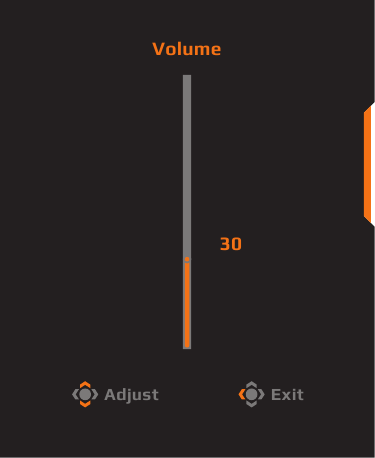
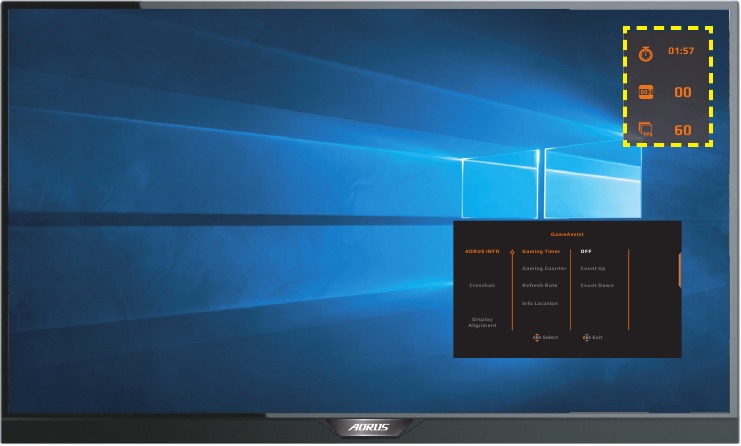





















Need help?
Do you have a question about the AORUS FI27Q-P and is the answer not in the manual?
Questions and answers